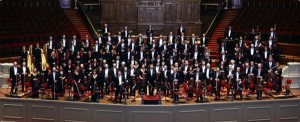THE CONCERTGEBOUW IS THE REAL THING
Chetana Nagavajara
The Concertbouw Orchestra at its home in Amsterdam
The Concertgebouw Orchestra is in a category of its own. The concert on 4 September 2012 in the Philharmonic Berlin under Mariss Jansons was a revelation to me in the same manner as the Munich Philharmonic under Celibidache. Having experienced the Berlin Philharmonic in recent years, I was struck by the Concertgebouw’s total lack of self-aggrandissement: it was doing its utmost to serve the music: in other words they were not “self-serving”.
A few years ago, I interviewed an senior music critic of a Berlin newspaper and asked him about Simon Rattle. He was not trying to be rude or offensive, but simply said to me: “He should have stayed on in Birmingham.” I asked him further which conductor I should get a chance to hear live. Again without any hesitation, he gave an unequivocal answer: “Mariss Jansons”. For last night’s concert I bought a ticket at a much lower price than for a Thai musical, of course, behind the orchestra, so as to be able to observe the conductor. Well, this is Berlin. There were empty seats in the Philharmonie last night. A Berliner friend of mine, who taught at Chula for several years, told me that the Berliners are unashamedly local patriots; they only listen to their own Berlin Philharmonic, and never bother to go to a concert by a visiting foreign orchestra. (A concert by the BPO is given 3 times and always sold out months in advance.)
Now that I’m talking about Berlin, I can’t help feeling that its cultural managers are honest enough to try to catch up with 20th century music, although we are now living in the 21st century. So last night’s programme consisted of Schoenberg, Strawinsky, Barber and Varèse. Schoenberg’s A Survivor from Warsaw is scored for a narrator, a male chorus and orchestra. I now understand what Schoenberg meant by “Sprechgesang” (half-singing, half-speaking). How he used the orchestra to underpin the text was most impressive. But for me the summit of the evening was Strawinsky’s Symphonie des Psaumes which could touch your heart, whether you are a Christian or not. The orchestration was quaint, only the lower strings , namely the celli and double basses, were used, plus 2 pianos. A chorus also played a significant part, and the Radio Choir of Berlin was very distinguished indeed. I now realize that a great composer does not experiment with sounds for their own sake, but can use specific sounds to convey very profound emotions. This is a world so remote from Le Sacre du printemps. Towards the end of the symphony I had a feeling that Strawinsky was fairly close to my beloved Johannes Brahms in his Deutsches Requiem.
A concession had to be made to attract the public, so the old war horse, Adagio for Strings, by Samuel Barber was offered. How could the Concertgebouw make it sound so fresh? It was certainly not the “German sound” that we heard, but an opulent and resonant type of sound that in its high register went straight to your heart. At one point the supposedly acoustically flawless Philharmonie could not accommodate this sound: it became hoarse and harsh as though the sound reflectors and the ceiling were about to give in. The Philharmonie has spoiled itself in getting addicted to the Karajan sound, perhaps! The orchestra came out in full force, physically, with all types of weird percussive instruments, to perform Amériques by Edgard Varèse. One hearing did not suffice to convinced me that this is serious music. It sounded just deliberately exotic to me, like the Americas perceived by the French Romantic poet, Chateaubriand. But it very well served as a showpiece for the orchestra, and the conductor. One could hardly believe that such a complex score is “conductible” at all! But conducted it was. As I was watching Mariss Jansons’s beats,
I began to realize that conducting can be taught and learned – up to a certain level. Beyond that, it’s interpretation – and discovery.
I almost made a stupid mistake a few months ago (urged by my musician son) to make a trip to Hong Kong to hear the Concertgebouw there. The ticket prices were astronomical and the concert was sold out in no time. For me Berlin is more than a second choice. If you want to hear non-Berlin orchestras of the highest quality, do please come to Berlin. Tickets are always available. But to hear the august Berlin Philharmonic Orchestra, just be content with its “Digital Concert Hall”. Even Sir Simon Rattle, who a few years ago was accused of not being able to produce “the German sound”, has now bettered himself, thanks to the engineers perhaps!
Those (mostly young) musicians of the Concertgebouw do not have to engage in myth-making. They are the real thing.
